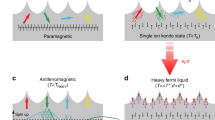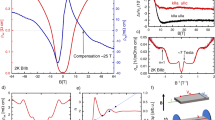Abstract
The recently proposed concept of a Hund's metal—a metal in which electron correlations are driven by Hund's rule coupling—can be used to explain the exotic magnetic and electronic behaviour of strongly correlated electron systems of multi-orbital metallic materials. Tuning the abundance of parameters that determine these materials is, however, experimentally challenging. Here, we show that the basic constituent of a Hund's metal—a Hund's impurity—can be realized using a single iron atom adsorbed on a platinum surface, a system that comprises a magnetic moment in the presence of strong charge fluctuations. The magnetic properties can be controlled by using the tip of a scanning tunnelling microscope to change the binding site and degree of hydrogenation of the 3d transition-metal atom. We are able to experimentally explore a regime of four almost degenerate energy scales (Zeeman energy, temperature, Kondo temperature and magnetic anisotropy) and probe the magnetic excitations with the microscope tip. The regime of our Hund's impurity can be tuned from an emergent magnetic moment to a multi-orbital Kondo state, and the system could be used to test predictions of advanced many-body theories for non-Fermi liquids in quantum magnets or unconventional superconductors.
This is a preview of subscription content, access via your institution
Access options
Subscribe to this journal
Receive 12 print issues and online access
$259.00 per year
only $21.58 per issue
Buy this article
- Purchase on Springer Link
- Instant access to full article PDF
Prices may be subject to local taxes which are calculated during checkout






Similar content being viewed by others
References
Paglione, J. & Greene, R. L. High-temperature superconductivity in iron-based materials. Nature Phys. 6, 645–658 (2010).
Stewart, G. R. Superconductivity in iron compounds. Rev. Mod. Phys. 83, 1589–1652 (2011).
Wang, F. & Lee, D.-H. The electron-pairing mechanism of iron-based superconductors. Science 332, 200–204 (2011).
Werner, P. et al. Satellites and large doping and temperature dependence of electronic properties in hole-doped BaFe2As2 . Nature Phys. 8, 331–337 (2012).
Yin, Z. P., Haule, K. & Kotliar, G. Kinetic frustration and the nature of the magnetic and paramagnetic states in iron pnictides and iron chalcogenides. Nature Mater. 10, 932–935 (2011).
de’ Medici, L., Mravlje, J. & Georges, A. Janus-faced influence of Hund's rule coupling in strongly correlated materials. Phys. Rev. Lett. 107, 256401 (2011).
Mravlje, J. et al. Coherence–incoherence crossover and the mass-renormalization puzzles in Sr2RuO4 . Phys. Rev. Lett. 106, 096401 (2011).
Werner, P., Gull, E., Troyer, M. & Millis, A. J. Spin freezing transition and non-Fermi-liquid self-energy in a three-orbital model. Phys. Rev. Lett. 101, 166405 (2008).
Anderson, P. W. Localized magnetic states in metals. Phys. Rev. 124, 41–53 (1961).
Kondo, J. Resistance minimum in dilute magnetic alloys. Prog. Theor. Phys. 32, 37–49 (1964).
Nozières, P. & Blandin, A. Kondo effect in real metals. J. Phys. France 41, 193–211 (1980).
Georges, A., de Medici, L. & Mravlje, J. Strong correlations from Hund's coupling. Annu. Rev. Condens. Matter Phys. 4, 137–178 (2013).
Haule, K. & Kotliar, G. Coherence–incoherence crossover in the normal state of iron oxypnictides and importance of Hund's rule coupling. New J. Phys. 11, 025021 (2009).
Hund, F. Zur deutung der molekelspektren. I. Z. Phys. 40, 742–764 (1927).
Hund, F. Zur deutung der molekelspektren. II. Z. Phys. 42, 93–120 (1927).
Carbone, C. et al. Correlated electrons step by step: itinerant-to-localized transition of Fe impurities in free-electron metal hosts. Phys. Rev. Lett. 104, 117601 (2010).
Gardonio, S. et al. Excitation spectra of transition-metal atoms on the Ag (100) surface controlled by Hund's exchange. Phys. Rev. Lett. 110, 186404 (2013).
Delgado, F. & Fernández-Rossier, J. Cotunneling theory of atomic spin inelastic electron tunneling spectroscopy. Phys. Rev. B 84, 045439 (2011).
Gauyacq, J.-P., Lorente, N. & Novaes, F. D. Excitation of local magnetic moments by tunneling electrons. Prog. Surf. Sci. 87, 63–107 (2012).
Heinrich, A. J., Gupta, J. A., Lutz, C. P. & Eigler, D. M. Single-atom spin-flip spectroscopy. Science 306, 466–469 (2004).
Hirjibehedin, C. F. et al. Large magnetic anisotropy of a single atomic spin embedded in a surface molecular network. Science 317, 1199–1203 (2007).
Oberg, J. C. et al. Control of single-spin magnetic anisotropy by exchange coupling. Nature Nanotech. 9, 64–68 (2014).
Otte, A. F. et al. The role of magnetic anisotropy in the Kondo effect. Nature Phys. 4, 847–850 (2008).
Huang, L., Wehling, T. O. & Werner, P. Electronic excitation spectra of the five-orbital Anderson impurity model: from the atomic limit to itinerant atomic magnetism. Phys. Rev. B 89, 245104 (2014).
Dubout, Q. et al. Controlling the spin of Co atoms on Pt(111) by hydrogen adsorption. Phys. Rev. Lett. 114, 106807 (2015).
Madhavan, V., Chen, W., Jamneala, T., Crommie, M. F. & Wingreen, N. S. Tunneling into a single magnetic atom: spectroscopic evidence of the Kondo resonance. Science 280, 567–569 (1998).
Nagaoka, K., Jamneala, T., Grobis, M. & Crommie, M. F. Temperature dependence of a single Kondo impurity. Phys. Rev. Lett. 88, 077205 (2002).
Prüser, H. et al. Long-range Kondo signature of a single magnetic impurity. Nature Phys. 7, 203–206 (2011).
Surer, B. et al. Multiorbital Kondo physics of Co in Cu hosts. Phys. Rev. B 85, 085114 (2012).
Fu, Y.-S. et al. Manipulating the Kondo resonance through quantum size effects. Phys. Rev. Lett. 99, 256601 (2007).
Liu, L. et al. Reversible single spin control of individual magnetic molecule by hydrogen atom adsorption. Sci. Rep. 3, 1210 (2013).
Mugarza, A. et al. Spin coupling and relaxation inside molecule–metal contacts. Nature Commun. 2, 490 (2011).
Parks, J. J. et al. Mechanical control of spin states in spin-1 molecules and the underscreened Kondo effect. Science 328, 1370–1373 (2010).
Tsukahara, N. et al. Evolution of Kondo resonance from a single impurity molecule to the two-dimensional lattice. Phys. Rev. Lett. 106, 187201 (2011).
Zhao, A. et al. Controlling the Kondo effect of an adsorbed magnetic ion through its chemical bonding. Science 309, 1542–1544 (2005).
Gull, E. et al. Continuous-time Monte Carlo methods for quantum impurity models. Rev. Mod. Phys. 83, 349–404 (2011).
Hanl, M. et al. Iron impurities in gold and silver: Comparison of transport measurements to numerical renormalization group calculations exploiting non-Abelian symmetries. Phys. Rev. B 88, 075146 (2013).
Khajetoorians, A. A. et al. Spin excitations of individual Fe atoms on Pt(111): impact of the site-dependent giant substrate polarization. Phys. Rev. Lett. 111, 157204 (2013).
Chilian, B., Khajetoorians, A. A., Wiebe, J. & Wiesendanger, R. Experimental variation and theoretical analysis of the inelastic contribution to atomic spin excitation spectroscopy. Phys. Rev. B 83, 195431 (2011).
Nevidomskyy, A. H. & Coleman, P. Kondo resonance narrowing in d- and f-electron systems. Phys. Rev. Lett. 103, 147205 (2009).
Zhang, Y.-h. et al. Temperature and magnetic field dependence of a Kondo system in the weak coupling regime. Nature Commun. 4, 2110 (2013).
Žitko, R. Kondo resonance lineshape of magnetic adatoms on decoupling layers. Phys. Rev. B 84, 195116 (2011).
Costi, T. A. Kondo effect in a magnetic field and the magnetoresistivity of Kondo alloys. Phys. Rev. Lett. 85, 1504–1507 (2000).
Wallis, R. H. & Wyatt, A. F. G. Exchange scattering in Ti-doped Al/Al oxide/Ag tunnel junctions. II. Magnetic field. J. Phys. C 7, 1293 (1974).
De Haas, W. J., de Boer, J. & van dën Berg, G. J. The electrical resistance of gold, copper and lead at low temperatures. Physica 1, 1115–1124 (1934).
Anderson, P. W. The resonating valence bond state in La2CuO4 and superconductivity. Science 235, 1196–1198 (1987).
Wiebe, J. et al. A 300 mK ultra-high vacuum scanning tunneling microscope for spin-resolved spectroscopy at high energy resolution. Rev. Sci. Instrum. 75, 4871–4879 (2004).
Karolak, M., Wehling, T. O., Lechermann, F. & Lichtenstein, A. I. General DFT ++ method implemented with projector augmented waves: electronic structure of SrVO3 and the Mott transition in Ca2−xSrxRuO4 . J. Phys. Condens. Matter 23, 085601 (2011).
Acknowledgements
The authors thank H. Brune, F. Donati, M. Ternes and the group of S. Lounis for discussions. A.A.K., T.S., M.S., J.W. and R.W. acknowledge funding from SFB668-A1 and GrK1286 of the Deutsche Forschungsgemeinschaft (DFG). A.A.K. also acknowledges project no. KH324/1–1 from the Emmy-Noether-Program of the DFG. R.W. and J.W. acknowledge funding from European Research Council Advanced Grant ‘ASTONISH’. M.V., T.O.W. and A.I.L. acknowledge support from DFG Research Unit FOR1346. M.V. and A.I.L. also acknowledge computer support NIC, Forschungzentrum Jülich, under project HHH14. A.S. and J.K. acknowledge support from project 15-05872J of the Czech Science Foundation.
Author information
Authors and Affiliations
Contributions
A.A.K., M.S. and T.S. performed the experiments. A.A.K., M.S., T.S. and J.W. analysed the experimental data. M.V., T.O.W. and A.I.L. performed the ab initio and QMC calculations. A.S., J.K., M.V. and T.O.W. performed the ED calculations. A.A.K. and J.W. conceived and designed the experiments. A.A.K., M.V., T.O.W. and J.W. wrote the manuscript. All authors discussed the results and commented on the manuscript.
Corresponding author
Ethics declarations
Competing interests
The authors declare no competing financial interests.
Supplementary information
Supplementary information
Supplementary information (PDF 2111 kb)
Rights and permissions
About this article
Cite this article
Khajetoorians, A., Valentyuk, M., Steinbrecher, M. et al. Tuning emergent magnetism in a Hund's impurity. Nature Nanotech 10, 958–964 (2015). https://doi.org/10.1038/nnano.2015.193
Received:
Accepted:
Published:
Issue Date:
DOI: https://doi.org/10.1038/nnano.2015.193
This article is cited by
-
Tuning orbital-selective phase transitions in a two-dimensional Hund’s correlated system
Nature Communications (2023)
-
Probing the topologically trivial nature of end states in antiferromagnetic atomic chains on superconductors
Nature Communications (2023)
-
Fe3GeTe2: a site-differentiated Hund metal
npj Computational Materials (2022)
-
Magnetic control over the fundamental structure of atomic wires
Nature Communications (2022)
-
Signatures of Mottness and Hundness in archetypal correlated metals
Nature Communications (2019)



